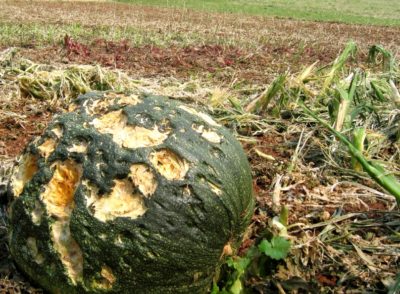Hail
You’ve survived the early spring frosts and your garden is thriving, thanks to the warm, sunny days of early summer. The cool-season crops, such as carrots, lettuce and radishes are at their prime and the tomatoes and beans are starting to climb their cages.
But don’t get your hopes up yet. Hail is perhaps the most discouraging of all extreme weather because it’s completely unpredictable and hard to prepare for. Hail usually arrives in early summer – in June in my area. It’s most common in the Plains states, which are also the states most likely to see tornadoes.
Hail and tornadoes both get their start when strong, warm updrafts mix with cold downdrafts. The updrafts lift drops of rain high in to the atmosphere where they turn to ice. Downdrafts deliver the ice particles back down to warmer layers of air where the particles partially melt. Another updraft lifts the particles again and they gain another layer of ice. This process continues until the balls of ice are too heavy to remain afloat and fall to earth as—you guessed it—hail.
Hail usually accompanies severe thunderstorms and rainstorms, which weather forecasters are able to predict, but forecasters can’t always predict hail accurately. In most cases, you’ll get a few hours notice at the most.
In years past, when a hailstorm hit, I rallied the kids out to the garden to throw buckets and lawn chairs over our precious produce. If hail storms were a rare event, this willy-nilly method would probably suffice. We’ve endured major hailstorms every summer for the last five years though, so I’ve decided that a more proactive approach is probably in order. Below are the strategies I use for dealing with hail.
- My husband built mini-hoop tunnels from PVC pipe. The tunnels sit snugly over my raised beds. In the early spring, I cover the tunnels with floating row covers or agricultural fabric. This fabric keeps the soil warm so seeds germinate faster. It also protects young seedlings from flea beetles, rabbits, and deer. Bird netting covers the hoop tunnels that lie over my strawberries. Come fall, the agricultural fabric extends the growing season and protects fall crops. But during hail season, the hoops are there mainly to protect the garden from falling ice. If a hail storm is predicted, I throw tarps and thick plastic over the tunnel. The plastic won’t protect the plants from very large pieces of hail, but it eliminates most damage.
- Most hoop tunnels are 2 to 3 feet tall, which makes them impractical for protecting large plants, such as tomatoes. Here’s a clever trick from the University of Nebraska-Lincoln. Stretch a sheet of hardware cloth over the tops of tomato cages. Allow the hardware cloth to fall over the sides of the cages. Netting wrapped around the cages offers added protection.
The first glimpse of the garden after a hailstorm can be heartbreaking. Last year, the storm pummeled by lettuce to the ground and completely stripped the raspberries. The stems and trunks of the tomato plants were covered with nicks and cuts. It’s hard to tell, though, immediately after a storm if damage is temporary or permanent. Don’t start tearing up the garden right away. Young root vegetables with shredded leaves are probably goners, although older root vegetables can probably be harvested. Lettuce usually sprouts new growth within a week or two, and tomatoes come back if the hail occurs early enough in the season.
- The best course to take immediately is to fertilize the plants with a diluted fish emulsion solution and spray the leaves with a seaweed extract foliar spray. Seaweed extract stimulates growth hormones and can promote healing better than almost anything else. Continue to water the garden.
- Observe the garden in a week or so. If you see new growth emerging, the plant will likely survive, although it might not recover quickly enough to produce a large harvest. Remove any plants that haven’t recovered and replant them if possible.
- Grapes, berries, and orchard trees are usually too big to shield from hail, although you can try throwing a tarp over them. After the storm, fertilize them with fish emulsion and seaweed extract as described above. Spraying large orchard trees with seaweed extract is impractical, but smaller vines and berries can be treated this way. Prune out any broken limbs and wait to see if the plant survives.
The Secrets Of Sea Minerals To Grow More “Nutritionally-Dense Food” Than You Can Possibly Eat!
Heavy Rains And Cool Weather
When it comes to rain, many areas experience feast or famine conditions. In the Rocky Mountains, for example, we go for weeks with no rain followed by a few days of cool weather and drenching rainstorms. These storms are a blessing for the lawn, but wreak havoc in the garden. The main problem I’ve found is that of blossom end rot on tomatoes and occasionally, squash. Inconsistent periods of dry conditions followed by very wet conditions causes the tomatoes to form a brown leathery patch on the blossom end of the tomato.
I try to keep the soil in the vegetable garden slightly moist at all times so the contrast is not so stark when heavy rains occur. If I know heavy rains are coming, I pick all the tomatoes that are close to maturity.
Extended periods of cool weather can also prevent pollination. Bees aren’t active during rainy weather and the plants often drop their flowers before they become pollinated. Your only recourse in this situation is to wait for the weather to change.
Frosts
Fall frosts are easier to contend with than hail or heavy rains because they’re usually predicted and unless you get a freak storm in early September, most of the crops are dwindling anyway. Weather forecasters and gardeners alike use the terms “light frost,” “heavy frost,” and “hard freeze” to describe cold weather. Some crops, including lettuce, spinach, carrots, and cabbage can tolerate a light frost, which is defined as temperatures between 32 and 28 degrees. A hard frost occurs when temperatures fall below 28 degrees. At this point, it’s time to close up shop for the season unless you’re using hoop tunnels or cold frames.
In my garden, I’m usually most concerned about the tomatoes. They’re often still going strong and the frost catches me in the midst of canning salsa and spaghetti sauce. Tomatoes can tolerate only the lightest frost, but green tomatoes can ripen indoors if you pick them in time. Throw a blanket over the vines if a light frost threatens, but it’s time to start picking if colder weather is forecast.
Pick all the green tomatoes that are of a mature size. Toss the small, hard ones to the compost pile because they won’t ripen well. Green tomatoes can be stored in a single layer in a box. Some gardeners wrap each one in newsprint, but this seems like overkill to me. Store the tomatoes in a cool place where temperatures range from 55 to 65 degrees. I store mine in my basement. Stored in this way, the tomatoes will ripen slowly in two to four weeks. Just check them every day or so and bring up the ones that are almost ripe. Allowed to sit on your kitchen counter, they’ll ripen to perfection in a day or so.
 Off The Grid News Better Ideas For Off The Grid Living
Off The Grid News Better Ideas For Off The Grid Living





